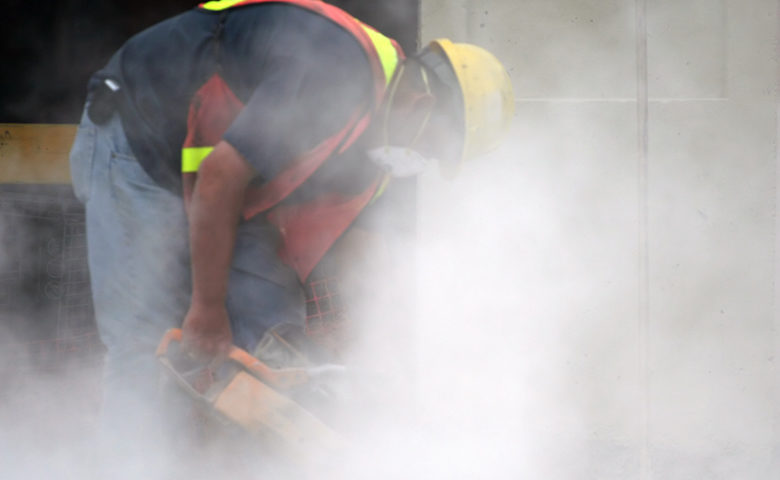Crystalline silica is a common mineral found in sand, stone, concrete and mortar. Although it occurs naturally in our environment, it’s a dangerous substance that can cause debilitating illnesses and death.
The dangers of silica have been recognized for decades. It can cause silicosis—permanent and non-reversible lung disease—as well as lung cancer, chronic obstructive pulmonary disease (COPD), and kidney disease.
Silica dust exposure
Most serious exposure to silica is linked to construction, and workers in the manufacturing, mining, and transportation and warehousing industries may also have some exposure to silica. Primary exposure to silica is inhalation. Ingestion and skin absorption are not significant and it’s the effect of silica on lungs that leads to silicosis.
There are three types of silicosis:
- Chronic silicosis: occurs after 10+ years of exposure with relatively low exposure
- Accelerated silicosis: occurs after 5-10 years after exposure to high concentration
- Acute silicosis: can occur after as little as a few weeks or as long as 2 years after exposure to extremely high concentrations
Symptoms such as shortness of breath, severe cough, weakness, fever, weight loss, and night sweats can be deceiving, and people affected may sometimes think that they’re struggling with recurring bouts of flu. It’s also worth noting that people with silicosis are also more prone to infections. There is no cure for silicosis.
Respirable crystalline silica is created during “cutting, sawing, grinding, drilling, and crushing stone, rock, concrete, brick, block, and mortar.” Workers involved in such activities (at work or at home) are exposed to silica dust. Although respirable crystalline silica needs to be handled with caution, silicosis is preventable.
Employee protection
There are two respirable crystalline silica OSHA standards: one for construction, and one for general industry and maritime. Both require employers to limit respirable silica exposure and to take other steps to protect workers.
Despite some differences in regulations, all industries have to follow a number of similar rules and these begin with the hierarchy of controls.
Engineering controls
Engineering controls are at the top of the list as they aim to remove or isolate silica dust at the point where it’s made. Elimination or substitution is always the best solution because it protects everyone in the area.
There are three major types of engineering controls to control silica: wet methods, vacuum dust collection and isolation.
- Wet methods involve using water or foam to stop dust from becoming airborne. This can be done at the point the dust is made, be included in wet sweeping, or in other situations where dust may become airborne.
- Vacuum dust collection systems suck the dust up and remove it at the point it’s made.
- Isolation aims to separate the employee from the dust.
Work practice controls
Practice controls provide options for performing tasks in ways that reduce dust exposure. This could include scheduling, putting up warning signs, implementing codes of practice, designing relevant procedures, providing training and air monitoring.
Two examples of controls are immediately addressing an engineering control that is not working properly, and scheduling dusty tasks when other employees aren’t present.
PPE
Respirators are the least effective type of protection and they’re required when engineering controls are not enough to protect workers. However, even when respirators are deemed necessary, the employer must still use engineering and work practice controls to lower exposures as much as possible.
In addition, respirators are only effective if they are properly selected, fitted, maintained, and worn. However, even under these conditions, they protect only the people wearing them.
Training
Safety training is a vital part of employer responsibilities and it provides a way of ensuring that workers remain healthy while working around silica dust. Training needs to be memorable so that employees understand:
- silica hazards and employer responsibilities,
- work operations that result in silica exposure and ways to limit exposure,
- work practice controls that involve performing tasks in ways that decrease exposure, and
- safe and effective PPE use.
Air sampling and medical examinations
Employers in all industries must assess worker exposures to silica if it may be at or above an action level of 25 micrograms of silica per cubic meter of air ( µg/m³) averaged over an 8-hour day. It is also their responsibility to then protect workers from exposures above 50 µg/m³ (again, averaged over an 8-hour day).
Additionally, employers must offer their workers medical exams that include chest X-rays and lung function tests. These should be offered every three years for workers exposed at or above the action level for 30 or more days per year.
Silica exposure protection plan
Organizations that require their employees to work around silica dust need also to establish and implement a written exposure control plan, identifying tasks that involve exposure and including methods used to protect workers. They should keep records of exposure measurements, data, and medical exams.
Silica dust is deadly and it’s the employer’s responsibility to protect workers and ensure their health and safety. If organizations don’t have an EHS expert on staff, they should research their legal requirements in-depth or hire an external consultant to provide them with the relevant information and training. Prevention is key and there is a lot to think about. And because silica dust is so dangerous, the points above should only be a starting point for anyone looking to learn more about this subject.
The above information is not exhaustive. Always consult the complete OSHA regulations and, if you need clarification, consult an expert in silica-related safety.

